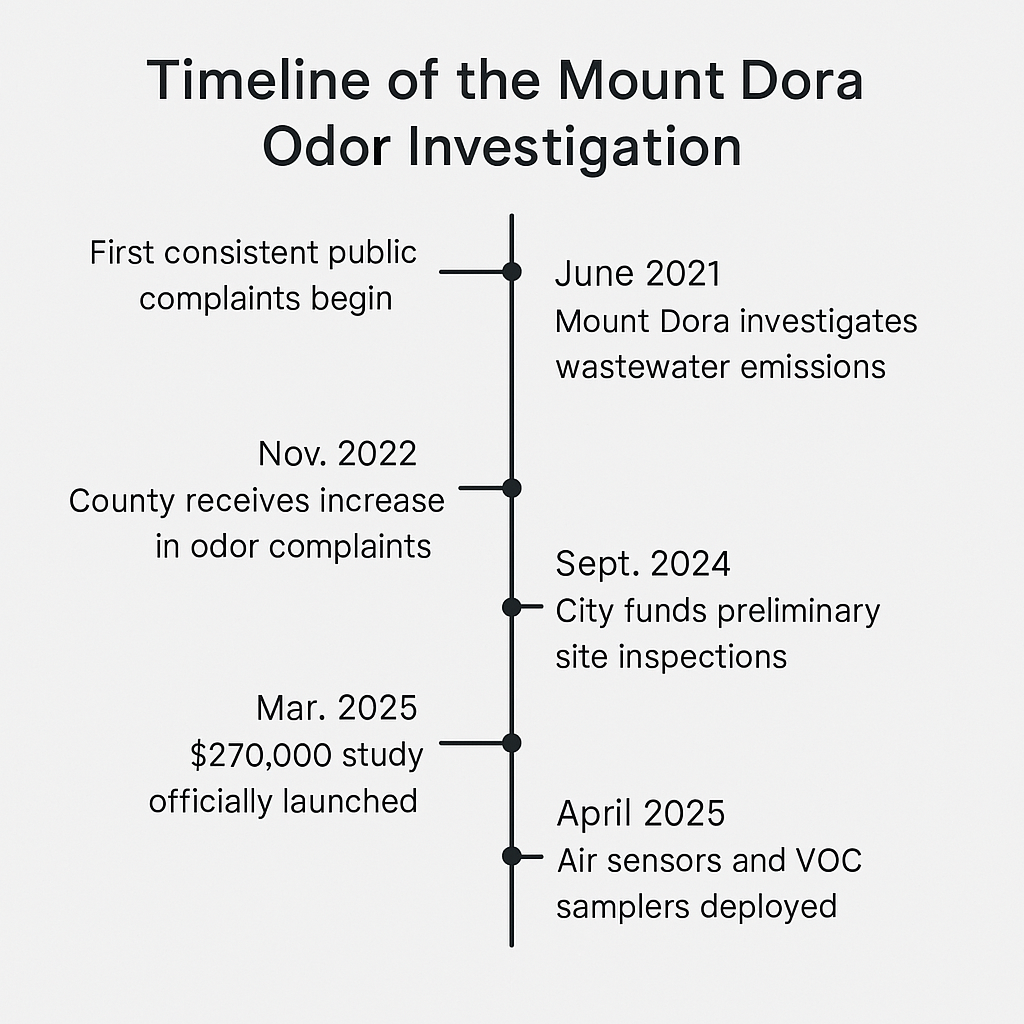What’s That Smell? Mount Dora, Florida Launches $270K Study to Solve Ongoing Odor Mystery

Mount Dora, a charming lakeside city in Central Florida known for its festivals and historic downtown, is now in the spotlight for an unexpected and unwelcome reason: a foul, industrial-like odor that has lingered for years. With complaints rising and public concern growing, the City of Mount Dora and Lake County have invested $270,000 in a comprehensive study to finally pinpoint the source of the smell.
The Mount Dora Mystery Smell: What Are Residents Experiencing?
The scent has been described as “chemical,” “industrial,” and “something burning in the distance.” The odor is particularly noticeable near neighborhoods like Sullivan Ranch, Stoneybrook Hills, and areas adjacent to U.S. 441 and State Road 46. Residents report the smell being stronger during early mornings, on humid days, or when the wind shifts.
Common Complaints Include:
-
Burning rubber or plastic smell
-
Eye and throat irritation
-
Persistent headaches and breathing issues
-
Inability to enjoy outdoor activities
Investigating the Source: What Could Be Causing the Odor in Mount Dora?
The city has suspected multiple possible contributors to the smell, but no single confirmed source has yet emerged.
1. Mid-Florida Materials Landfill
Located off State Road 46, this landfill has been a recurring suspect. The smell has been described by locals as emanating from this direction, especially when wind patterns shift southward.
2. Mount Dora Wastewater Treatment Plant
Situated off James P. Snell Drive near U.S. 441, the city’s wastewater plant could also be emitting gases under certain atmospheric conditions.
3. Industrial and Commercial Activity
Nearby mulch facilities, transfer stations, and light industrial operations could be generating chemical-like or decomposition-related odors.
4. Environmental and Natural Decay
Natural processes such as decaying vegetation in wet retention ponds or storm drains may also be contributing, especially during Florida’s hot, rainy seasons.
The $270,000 Study: Mount Dora’s Strategy for Identifying the Odor
In collaboration with Lake County, Mount Dora has engaged environmental consulting firms Halff Associates and V&A Consulting Engineers to lead a full-scale odor investigation.
Goals of the Study:
-
Map odor hotspots using community reports and sensor data
-
Analyze air samples for volatile organic compounds (VOCs) and sulfuric gases
-
Trace atmospheric conditions to determine when and where the smell is strongest
-
Identify root causes and recommend mitigation strategies
Key Locations of Interest:
-
Sullivan Ranch and adjacent neighborhoods
-
Stoneybrook Hills and the Loch Leven area
-
Vicinity of U.S. 441 and SR-46
-
Wastewater facilities and local transfer stations
Health Impacts: Is the Mount Dora Smell Dangerous?
City officials have emphasized that while the odor is disturbing, it has not yet been classified as a public health hazard. However, residents have consistently reported symptoms that suggest exposure to airborne pollutants may be having an effect.
Reported Health Symptoms:
-
Difficulty breathing
-
Coughing and chest tightness
-
Eye, nose, and throat irritation
-
Headaches and nausea
-
Increased anxiety due to persistent odors
Sensitive groups, including children, elderly individuals, and people with respiratory conditions such as asthma or COPD, are advised to limit outdoor exposure when odors are strong.
Timeline of Events: From Complaints to Action

What Areas Are Most Affected by the Odor in Mount Dora?
Based on community feedback, these neighborhoods and areas report the strongest and most frequent smells:
-
Sullivan Ranch
-
Stoneybrook Hills
-
Loch Leven
-
Downtown Mount Dora (occasionally during wind shifts)
-
U.S. 441 corridor near the wastewater plant
City officials are also looking to install real-time odor mapping systems to allow residents to log their experiences and help pinpoint odor patterns.
Potential Long-Term Solutions
Once the study identifies the likely culprits, Mount Dora and Lake County may consider several mitigation measures:
Options Being Evaluated:
-
Upgrading wastewater infrastructure to improve odor control
-
Installing air scrubbers or carbon filters at suspected sources
-
Changing landfill operations or mulch handling practices
-
Adding odor neutralizers to drainage systems
-
Increasing vegetative buffers around odor-producing sites
Public education campaigns and ongoing air quality monitoring will also be essential to sustaining improvements.
What Residents Can Do Right Now
Immediate Steps:
-
Report odor incidents through the city’s online 311 portal or hotline
-
Keep windows closed and use indoor air purifiers when odors are present
-
Join public meetings and workshops about the study’s progress
-
Sign up for email updates from the City of Mount Dora on environmental initiatives
Community Engagement:
-
Support environmentally conscious policies and infrastructure upgrades
-
Participate in neighborhood air monitoring efforts
-
Advocate for sustainable growth practices to reduce environmental strain
Looking Ahead: A Fresh Future for Mount Dora
Mount Dora’s leadership has shown clear dedication to resolving the persistent odor issue. The city’s investment in a detailed, science-driven approach reflects a long-term commitment to residents’ health, comfort, and quality of life.
As the study progresses, more information will become available to guide policy, identify culprits, and take tangible steps to restore Mount Dora’s clean, scenic charm.
Categories
Recent Posts










GET MORE INFORMATION

